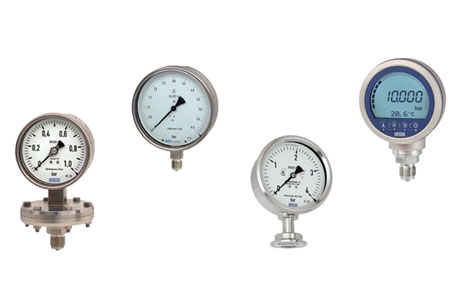What Is The Principle Of Manometer Pressure Gauges?
Key Takeaway
Manometer pressure gauges work based on the principle of balancing fluid columns. A liquid, often water or mercury, is placed in a U-shaped tube. The pressure to be measured is applied to one side, causing the liquid to move.
The difference in liquid levels indicates the pressure. This simple mechanism provides accurate readings, especially for low-pressure applications. It’s widely used for calibration and testing purposes.
Introduction to Manometer Pressure Gauges
Manometer pressure gauges are traditional instruments used to measure and display pressure levels. They function based on the principle of balancing a column of liquid, typically mercury or water, against the pressure to be measured. This simple yet effective method provides accurate readings in various applications.
Manometers are valued for their reliability and ease of use, often employed in laboratory settings and HVAC systems. Despite advancements in electronic measurement, manometers remain a popular choice due to their straightforward design. This introduction provides an overview of manometer pressure gauges, exploring their operation, advantages, and relevance in today’s technology-driven world.

How the Hydrostatic Principle Works in Manometers
The hydrostatic principle is a fundamental concept in fluid mechanics that explains how manometers measure pressure. This principle is based on the understanding that the pressure exerted by a fluid at rest is proportional to the depth of the fluid and its density. In a manometer, this principle is utilized by measuring the difference in fluid levels within a U-shaped tube or other configurations. When pressure is applied to one side of the manometer, the fluid within the tube is displaced, creating a height difference between the two sides. This height difference, known as the hydrostatic head, is directly proportional to the applied pressure, allowing for accurate pressure measurement.
Manometers are widely used in various applications due to their simplicity and precision. They are particularly effective in measuring low to moderate pressures and are often employed in laboratory settings, HVAC systems, and industrial processes. The choice of fluid within the manometer, typically a liquid such as water, mercury, or oil, depends on factors such as the pressure range, chemical compatibility, and desired accuracy. Mercury is commonly used for its high density, which allows for smaller and more precise measurements. However, due to environmental concerns, alternatives like water or oil are increasingly being used.
Understanding the hydrostatic principle is essential for interpreting manometer readings and ensuring accurate pressure measurements. The accuracy of a manometer depends on factors such as the fluid’s density, the tube’s dimensions, and the absence of air bubbles or leaks. Calibration and maintenance are crucial to maintaining the reliability of a manometer, as any discrepancies can lead to incorrect measurements and potential process inefficiencies. By leveraging the hydrostatic principle, manometers provide a straightforward and effective means of pressure measurement, contributing to the safe and efficient operation of various systems and processes.
Types of Manometers and Their Working Principles
Manometers are categorized based on their design and application. Here’s an overview of common types:
1. U-Tube Manometer: The simplest design, it uses a U-shaped tube filled with liquid. The difference in liquid height directly indicates pressure.
2. Inclined Manometer: Designed for low-pressure measurements, the tube is inclined to amplify small height changes for better readability.
3. Well-Type Manometer: Features a large reservoir on one side and a tube on the other. It measures absolute or differential pressure.
4. Digital Manometer: Combines traditional principles with electronic sensors for precise readings and modern convenience.
Each type is suited for specific applications, ensuring versatility in pressure measurement.
Advantages and Limitations of Manometer Gauges
Manometers offer several benefits but also come with limitations that should be considered:
Advantages:
High Accuracy: Provides precise pressure readings, ideal for calibration and reference purposes.
Cost-Effective: Simple design makes it affordable and easy to maintain.
No Power Requirement: Operates without electricity, making it reliable in remote areas.
Direct Measurement: Offers a visual representation of pressure differences.
Limitations:
Fragility: Glass tubes are prone to breakage.
Limited Range: Not suitable for high-pressure measurements.
Time-Consuming: Requires manual readings, which can be slow compared to digital gauges.
Liquid Sensitivity: Variations in liquid density or temperature can affect accuracy.
Despite these limitations, manometers are trusted for applications where precision outweighs speed.
Common Applications of Manometer Pressure Gauges
Manometer pressure gauges are widely used in HVAC systems to measure airflow and ensure proper system balance. Their high accuracy makes them ideal for monitoring air duct pressure, filter performance, and fan efficiency, ensuring optimal system operation. Additionally, their simplicity and reliability make them a trusted tool for troubleshooting and maintenance in heating and cooling systems.
In industrial settings, manometers play a critical role in process control and equipment calibration. They are commonly used to measure pressure in pipelines, gas storage tanks, and liquid systems. Their ability to handle both differential and static pressure makes them suitable for industries like oil and gas, chemical processing, and water treatment, where precise pressure monitoring is essential for safety and efficiency.
Manometers are also valuable in scientific research and laboratories, where precision is paramount. They are used in experiments involving fluid dynamics, gas laws, and material testing. Inclined manometers, in particular, are favored for their ability to provide detailed low-pressure readings, enabling researchers to conduct accurate and reliable measurements.
Conclusion
Manometer pressure gauges operate on the principle of balancing the pressure to be measured against a known reference pressure, typically atmospheric pressure. The difference in pressure causes a change in the height of a liquid column within the manometer, which is then measured.
This principle allows for accurate measurement of low pressures, making manometers particularly useful in laboratory settings and for calibrating other pressure measurement devices. Understanding the underlying principle is essential for correctly using and interpreting readings from manometer pressure gauges.

